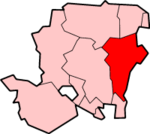Alton, Hampshire
| Alton | |
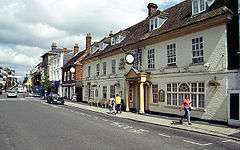 Alton. Looking north east along the High Street |
|
 Alton |
|
| Population | 17,816 |
|---|---|
| OS grid reference | SU716394 |
| Civil parish | Alton |
| District | East Hampshire |
| Shire county | Hampshire |
| Region | South East |
| Country | England |
| Sovereign state | United Kingdom |
| Post town | ALTON |
| Postcode district | GU34 |
| Dialling code | 01420 |
| Police | Hampshire |
| Fire | Hampshire |
| Ambulance | South Central |
| EU Parliament | South East England |
| UK Parliament | East Hampshire |
Coordinates: 51°08′59″N 0°58′37″W / 51.1498°N 0.9769°W
Alton is a market town and civil parish in the East Hampshire district of Hampshire, England. It is located across a valley on the source of the River Wey. According to the 2011 census, it has a population of 17,816. The town is famous for its connection with Sweet Fanny Adams.
The town was recorded in the Domesday Survey of 1086 under the name Aoltone and was notable for having the most valuable market recorded therein. The Battle of Alton occurred in the town during the English Civil War. The town contains three secondary schools and its own railway station.
History
Early history
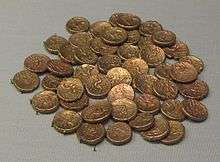
The Alton Hoard of Iron Age coins and jewellery was found in the vicinity of the town in 1996 and is now in the British Museum.[1] A Roman road ran from Chichester to Silchester and there is evidence of a Roman posting station at Neatham near Alton, probably called Vindomis, and a ford across the River Wey. Centuries later, an Anglo-Saxon settlement was established in the area and a large 7th century cemetery has been discovered during building excavations. It contained a selection of grave goods which included the Alton Buckle which is on display in the Curtis Museum, and is considered to be the finest piece of Anglo Saxon craftsmanship found in Hampshire. The buckle was found in the grave of a warrior, and has a silver-gilt body, set with garnets and glass.[2]
The River Wey has a source in the town, and the name Alton comes from an Anglo-Saxon word "aewielltun" meaning "farmstead at the source of the river".[3][4]
In 1001 Danish forces invaded England during the First Battle of Alton. When they reached Alton, the forces of Wessex came together and fought against them. About 81 Englishman were killed, including Ethelwerd the King's high-steward, Leofric of Whitchurch, Leofwin the King's high-steward, Wulfhere a bishop's thane, and Godwin of Worthy, Bishop Elfsy's son. Danish casualties were higher, however the Danes won the battle and fleeing Englishmen took refuge in Winchester.[5][6]
Alton is listed as having the most valuable recorded market in the Domesday Book under the name Aoltone in the 'Odingeton Hundred — Hantescire'.[2][2][7][7]

The Treaty of Alton was an agreement signed in 1101 between William the Conqueror's eldest son Robert, Duke of Normandy and his brother Henry I of England. Henry had seized the throne while his elder brother was away on the first crusade. Robert returned to claim the throne, landing in Portsmouth. The two brothers met in Alton and agreed terms which formed the Treaty of Alton. Part of the main street through Alton is called Normandy Street, probably reflecting this event.
Middle Ages
The first recorded market in Alton was in 1232, although the market at Neatham first recorded in the Domesday Book may also have been in the town.[8] Blome wrote in 1673 of a 'market on Saturdays, which is very great for provisions, where also are sold good store of living cattle'.[9] The Saturday market is featured on Kitchin's map of Hampshire (1751) which marks the town as Alton Mt. Sat.[10]
1307 was, in fact, the first year of Edward II’s reign but Edmund of Woodstock was not lord of the manor then. According to the Victoria County History (written after Curtis’ book):-
- ‘In 1273 Edward I granted the manor [of Alton Westbrook] to his mother, Queen Eleanor, who died in 1291, when it reverted to the Crown and was granted in 1299 as dower to his second wife, Margaret of France. On the death of Queen Margaret in 1317, it again came to the Crown, and Edward II gave it in 1319 to his brother Edmund of Woodstock, Earl of Kent.’
As can be seen, Queen Margaret held the manor until 1317 and so the fair could not have been granted to Edmund of Woodstock in 1307.
The correct date for the grant seems to be 22 November 1320 (according to the Charter Rolls, 14 Edward II, no.15). The grant was for a 9-day fair - the vigil [eve] and feast of Whitsuntide and seven days after.
The two main manors in Alton - Alton Eastbrook and Alton Westbrook - had a fair each. That of Alton Eastbrook has no extant charter, and may never have had one. It was originally held on St Lawrence’s Day and so its origin was, presumably, the patronal festival. The religious aspect would have ceased when the country was no longer Roman Catholic. This fair seems to have been held on Crown Close (which is in the manor of Alton Eastbrook) in the early 19th century. When this land was built upon, the fair moved and was held where ever the Westbrook fair was - the Market Place, various meadows and the Butts.
The date of the Eastbrook fair was changed to Michaelmas in the mid-18th century as it came during harvest time and the farmers were not satisfied. Some accounts for this fair in the early 18th century do survive and show that there was a cheese fair as well the usual mix of travelling and local people with stalls and stands - people selling lace, gloves, books, gingerbread, bodices, sugar plums, toys, soap and knives, to name but a few. By the late 19th century, this fair was said to be mainly for horses, sheep and, occasionally, hops. Alton still has an annual fair, but it now takes the form of a carnival.[4]
Modern period
Eggar's School was founded in 1640 by John Eggar of Moungomeries as the Free Grammar School. It later became known as Eggar's Grammar School. It occupied a site in Anstey Road until it moved to a new site in Holybourne in 1969.[11]
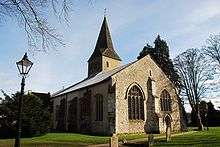
A battle was fought in Alton during the English Civil War. A small Royalist force was quartered in the town when on 13 December 1643 they were surprised by a Parliamentary army of around 5,000 men. The Royalist cavalry fled, leaving Sir Richard Bolle (or Boles) and his infantry to fight. Outnumbered, the Royalists were forced into the Church of St Lawrence, where Bolle was killed along with many of his men. Over 700 Royalist soldiers were captured and bullet holes from the battle are still visible in the church today.
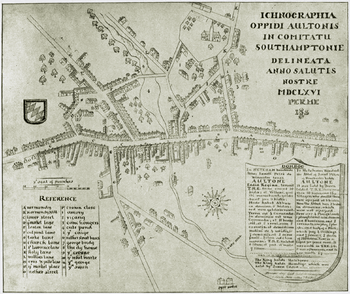
In 1665, Alton suffered an outbreak of bubonic plague, but soon recovered.[12] On Saturday, 24 August 1867, an eight-year-old girl, Fanny Adams, was murdered in Alton. Her assailant, Frederick Baker, a local solicitor's clerk, was one of the last criminals to be executed in Winchester. Fanny Adams' grave can still be seen in Alton cemetery. The brutal murder, so the story goes, coincided with the introduction of tinned meat in the Royal Navy, and the sailors who did not like the new food said the tins contained the remains of "Sweet Fanny Adams" or "Sweet F A".[13] The expression "sweet fanny adams" has an old-fashioned slang meaning of nothing.[14]
Governance
Prior to the Local Government Act 1972, Alton had fallen under the aegis of the (now defunct) Alton Urban District Council. The Act resulted in the dissolution of this body, and the establishment (on 1 April 1974) of the current Alton Town Council. The responsibilities of the Alton Urban District Council were divided between the new Alton Town Council, the Hampshire County Council and the newly formed East Hampshire District Council. The Council meets at the Town Hall, in Market Square, and the position of Mayor is currently held by Mr Matthew Bayliss.[15]
Geography
Alton is between Farnham 9 miles (14 km) to the northeast and Winchester 16 miles (26 km) to the southwest. London is 52 miles (84 km). Nearby Brockham Hill, situated 3.5 miles (5.6 kilometres) northeast of Alton, rises to 225 metres (738 feet) above sea level.
The nearby village of Bentworth is the highest village in Hampshire.
Climate
Along with the rest of South East England, Alton has a temperate climate which is generally warmer than the rest of the country. The annual mean temperature is approximately 9 °C (48.2 °F) and shows a seasonal and a diurnal variation. January is the coldest month with mean minimum temperatures between 0.5 °C (32.9 °F) and 2 °C (35.6 °F). June and July are the warmest months in the area with average daily maximum around 25.5 °C (77.9 °F).[16]
Economy
There have been a number of breweries in Alton since 1763. Coors Brewing Company (among the ten largest brewers in the world) had a brewery in Alton for fifty years, which produced Carling, Grolsch and Worthington. It closed in 2015 because it lost work from Heineken.[17]
Alton was famous in the 18th century for the manufacture of paper[4] and of dress materials including ribbed druggets, shallons, silks and serges, bombazine and figured barragons.[18][19]
Alton has businesses in the retail and service sectors in the centre of the town, and over a hundred businesses in the four industrial areas of Mill Lane, Newman Lane, Caker Stream and Omega Park, ranging from light industrial to computer software production.[20] Clarcor, TNT N.V. and Poseidon Diving Systems all have businesses in Alton's Industrial Site, Mill Lane.
One of Alton's largest commercial employers is the financial services sector. Lumbry Park, which used to be known as Lumbry Farm, is on the B3006 Alton to Selborne road, and is occupied by Inter Group Insurance Services (IGIS), a subsidiary of The Royal Bank of Scotland. Inter Group employs over 170 people on this site, and specialises in travel insurance. The company has operated in Alton since 1999. It was acquired by Churchill Insurance in 2001, becoming part of RBS Insurance division in 2003 as part of an RBS takeover. However, on 11 November 2008, Inter Group announced its proposal to close its office in Alton in August 2009 due to "changes in the travel insurance market",[21] leading to the loss of 104 full-time staff and around 16 part-timers. The head of Inter Group, Bob Andrews, said that the decision to close the Alton site had been forced by "a fundamental shift in the third-party travel insurance market in the last few years" and that "Major clients of Inter Group have recently taken their travel insurance business back in-house and sadly we have no alternative but to make this announcement today". He said, "We have explored every possible avenue before proposing this unfortunate action."
Alton was also home to the travel company TravelBag, the travel company owned by ebookers, who still have a shop in the town as well as The Adventure Company.
Alton has a range of chain stores and independent shops including greengrocers, butchers and a hardware shop. There are five main supermarkets that serve the town.[22][23]
The town houses various pubs and restaurants, including PizzaExpress.
Culture
Alton WordFest is a celebration of the spoken and written word held in late September or early October each year.[24] The festival includes writing competitions for children and adults, a children's spelling bee, a literary lunch, book launches and talks by authors and workshops. Since 2010, Alton WordFest has hosted The Pint Pot of Fire - a story-telling competition among champions representing writers' circles, public speaking groups and oral-tradition story-telling clubs from around the area. The Pint Pot of Fire has run annually since 2005 and was formerly held in Guildford (2005) and Farnham (2006–2009).[25]
The Allen Gallery serves as Alton's art gallery. It houses a large, permanent ceramics collection as well as temporary exhibitions.[26]
Holybourne Theatre is on the site of a former Nissen hut that was converted into a theatre by German prisoners-of-war during World War II.[27] Plays have been performed there since 1950, but the official opening was not until 1971.
Alton Morris was formed in 1979, and have been Morris Dancing both in the United Kingdom and abroad. They often perform at Alton street events.[28]
Local choirs include Alton Amateur Operatic and Dramatic Society, established in 1921, who perform two musical shows and one play each year in a wide variety of musical and dramatic styles.[29] Alton Community Choir sings unaccompanied Hampshire folk songs as well as some African, gospel, blues and calypso music.
Notable landmarks

The Alton Independent Cinema Project was formed in May 2011 to help secure the future of independent cinema in the town.
Alton Maltings was renovated in 2004-5 and is now the home of Harvest Church and is used by community groups, charities, private users and other organisations throughout the week. The Alton Maltings claims to be the widest wooden spanned building in Hampshire.
Alton Library was rebuilt in 2005 to a design by the County Council Architects. The new library contains a lending library, reference library, computer facilities and a cafe.[30]
Alton Sports Centre is open to the public and includes a swimming pool, gym, indoor and outdoor courts.
The Curtis Museum was founded in 1856 by Dr William Curtis and houses one of the finest local history collections in Hampshire
The Town Gardens contains a bandstand (built in 1935 for the Silver Jubilee of King George V), a children's playground, flower beds, trees and shrubs (4.5 acres (18,000 m2)). The bandstand was replaced in 2013 to commemorate Elizabeth II's Diamond Jubilee.
Anstey Park, is a large open space with playing fields and a small children's playground (32 acres (130,000 m2)); the park is home to the town's rugby club. King's Pond, with parking, a surfaced path all round, ducks and swans (11 acres (45,000 m2)) The Butts, 2 acres (8,100 m2) of common land now used for visiting circuses and fairs, and used in medieval and Tudor times for the weekly archery practice which all men were legally required to do (see archery butts) Flood meadows, about 15 acres (61,000 m2), lie close to the source of the River Wey through which rivulets weave and public footpaths give access through the diverse plant and animal life A Tourist Information Centre is in Cross and Pillory Lane (near Market Square in the centre of the town). Alton has 5 allotments: Borovere, Hawthorn, Spitalfields, Wooteys and Whitedown.
Education
Alton lies approximately midway between the University of Winchester and the University of Surrey at Guildford but its nearest University campus is the University for the Creative Arts in Farnham. It is home to Treloar's, an independent educational establishment founded in 1907 by Sir William Purdie Treloar, Lord Mayor of London, to provide education for young people with physical disabilities. Treloar's now runs Treloar College, a college of further education in Holybourne, and Treloar School in Upper Froyle about three miles (5 km) away. Treloar's provides specialist facilities, therapy and medical care to enable pupils to achieve their academic potential and develop their confidence and independence. Former pupils include comedian and actor Spike Breakwell, actress Julie Fernandez, mouth and foot painting artist Tom Yendell.[31]
The State secondary schools in Alton are Eggar's School (formerly the Grammar School), and Amery Hill School. There is an independent Catholic day school, Alton Convent School, which educates boys from 3 to 11 and girls from 3 to 18. Sixth-form education is provided by Alton College, which has gained outstanding inspection reports from Ofsted.
Transport
Alton station is on the National Rail network at the end of the Alton Line with a service to London Waterloo.
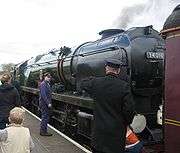
Alton railway station also serves as a terminus for the Mid Hants Railway commonly called 'The Watercress Line', a restored steam railway running between Alton and New Alresford, so called because it used to be used to transport fresh watercress to London.
The origins of the Watercress Line date back to 1861, the year in which Parliament granted consent for what was then known as the 'Alton, Alresford and Winchester Railway'. Four years later the Mid Hants Railway opened, and the train service continued until the line was closed in 1973. Then in 1977 the line was partially re-opened, in 1983 it was extended further, and in 1985 it was re-opened as far as Alton to connect with the mainline London service.[32]
Alton used to be a railway junction. As well as the Mid-Hants Railway, from 1903 to 1955 the Meon Valley Railway ran from Alton down the Meon Valley to join the Eastleigh to Fareham line at Fareham. The Basingstoke and Alton Light Railway ran north to Basingstoke.
In 2015 some passenger buses in the Alton area were operated by Stagecoach.[33]
Notable people
- William de Alton (c. 1330–1400), Dominican Friar, writer and theological philosopher during King Edward II's reign, became famous for asserting that the Virgin Mary was polluted with original sin[2]
- Edmund Spenser (1552–1599), the Elizabethan poet and contemporary of William Shakespeare, may have lived in a now well-preserved Tudor cottage at 1 Amery Street in about 1590. A plaque on the house states that he "lived some time in these parts".[2][18]
- John Pitts, biographical author, was born in Alton in 1560[34]

- John Murray (1741–1815), born in Alton, a pioneering minister of the Universalist church in the United States.[35]
- William Curtis (1746–1799), botanist, was born in Alton and served his apprenticeship as an apothecary before devoting the rest of his life to the study of British plants.[2]
- Jane Austen (1775–1817), Georgian novelist, lived in Chawton just outside Alton from 1809 until her death, and wrote or revised six novels there.[2]
- Cardinal Newman (1801–1890), English Catholic, lived in Alton from 1816 to 1819.[36]
- Iona and Peter Opie: Iona Opie (born 1923) and Peter Opie (1918–1982), folklorists and anthologists famed for their research into children's literature, and street and playground games. Their collection of children's literature has been donated to the Bodleian Library in Oxford.
- James William 'Jimmy' Dickinson (25 April 1925 – 8 November 1982 in Alton), an English football player. Dickinson holds the record number of league appearances for Portsmouth F.C. (764). Only Swindon Town's John Trollope (770) has made more appearances for a single club. His performances earned him a call-up to the England national football team. He won 48 caps for England, making him Portsmouth's most capped English player. During his record 845 club appearances for Pompey and his 48 England caps he was never once booked or sent off, earning him the nickname Gentleman Jim. There is a pub in Alton named after him called The Gentleman Jim.
- Graham Stratford, English cattle breeder, local politician and in 1974 the first Town Mayor of Alton Town Council.
- Graham Wilson (born 1958) studied at Eggar's Grammar School, from 1970 to 1976. Wilson, who worked briefly at the Harp Lager Brewery and Leisure Centre, is the author of several management text books, one of which "Problem Solving and Decision Making", is dedicated to his former Biology Teacher at Eggars, Dr Marion Phillips.
- Alison Goldfrapp (born 1966), singer of Goldfrapp.
- Yvette Cooper (born 1969), Member of Parliament and Chief Secretary to the Treasury, was educated at Eggar's School and Alton College.
Twin towns
Alton is twinned with:[37][38]
 Pertuis, Vaucluse, Provence-Alpes-Côte d'Azur, France[37]
Pertuis, Vaucluse, Provence-Alpes-Côte d'Azur, France[37] Montecchio Maggiore, Vicenza, Veneto, Italy[37]
Montecchio Maggiore, Vicenza, Veneto, Italy[37]
Nearest places
 |
Shalden Lasham |
Golden Pot | Holybourne Bentley |
 |
| Bentworth | |
East Worldham | ||
| ||||
| | ||||
| Four Marks | Chawton Upper Farringdon |
Selborne |
References
- ↑ British Museum Collection
- 1 2 3 4 5 6 7 Wey River (2006). "More about Alton, Hampshire". River Wey & Navigations. Retrieved 20 May 2006.
- ↑ Coates, Richard (1989), Place Names of Hampshire, Batsford. ISBN 0-7134-5625-6
- 1 2 3 Roberts, John (2005), Alton 2020, Alton: Alton Steering Group
- ↑ Ingram, Rev. James (trans.) (1823), The Anglo-Saxon Chronicle, London
- ↑ Hutton, Edward (1914), England of My Heart — Spring, J. M. Dent & Sons Ltd
- 1 2 Domesday Book, 1086
- ↑ Page, Mark (2003), "Medieval Alton: the Origins of a Market Town", Alton Papers, no. 7, Friends of the Curtis Museum and Allen Gallery: 3–6
- ↑ Blome's Hampshire, 1673
- ↑ Kitchin, Thomas (1760). A NEW Improved MAP of HAMPSHIRE from the best SURVEYS & INTELLIGENCES Divided into its HUNDREDS Shewing the several ROADS and true Measured Distances between Town and Town ALSO the Rectories & Vicarages the Parks and Seats of the Nobility & Gentry with other useful Particulars Regulated by ASTRONL. OBSERVATIONS. By T. Kitchin Geographer. Printed for R: Sayer in Fleet Street, Carrington Bowles in St. Pauls Church Yard, & R. Wilkinson No.58, Cornhill. (viewed on website: Jean and Martin Norgate (1996–2003). "Kitchin's Hampshire 1751, whole map". Old Hampshire Mapped. Retrieved 24 April 2006.)
- ↑ County Secretary (1989). "Former Alton Eggars Grammar School premises — transfer of charitable trusts". Hampshire County Council Schools Sub-Committee. Archived from the original on 1 January 2005. Retrieved 28 March 2006.
- ↑ Tim Lambert (2006). "A History of Alton, England". Local and National Histories — Histories of British and Irish towns, Histories of Nations, Ancient Civilisations and Miscellaneous Articles. Archived from the original on 15 June 2006. Retrieved 4 June 2006.
- ↑ "The true story of Sweet Fanny Adams | Hampshire Cultural Trust". hampshireculturaltrust.org.uk. Retrieved 2016-06-17.
- ↑ "sweet fanny adams Meaning in the Cambridge English Dictionary". dictionary.cambridge.org. Retrieved 2016-06-16.
- ↑ Alton Town Council: Your Council
- ↑ "About south-east England". Met Office. Retrieved 22 March 2010.
- ↑ "Molson Coors brewery closure job losses announced". BBC News. 8 December 2014. Retrieved 9 September 2015.
- 1 2 Wyatt, Sue (ed.) (1997), The Hidden Places of Dorset, Hampshire & the Isle of Wight, Altrincham, Cheshire: ·M & M Publishing Ltd, ISBN 1-871815-42-8
- ↑ Brookes, R., 1815 (16th edn): The General Gazetteer: (London)
- ↑ "Industrial Developments". Alton Chamber of Commerce & Industry. 2006. Archived from the original on 7 October 2006. Retrieved 26 November 2006.
- ↑ "Travel Insurance giant to close". Alton Herald. 2008. Retrieved 21 November 2008.
- ↑ "Supermarkets in Alton, Hampshire | Reviews - Yell". www.yell.com. Retrieved 2016-04-19.
- ↑ "Aldi Alton, Alton Retail Park - store address and opening hours - Opening Times in UK". openingtimesin.uk. Retrieved 2016-04-19.
- ↑ Alton WordFest
- ↑ Pint Pot of Fire, Alton
- ↑ Allen Gallery
- ↑ "Holybourne Theatre". Hampshire County Council. Holybourne Theatre. Retrieved 28 February 2014.
- ↑ "Alton Morris". Alton Morris dance. Archived from the original on 22 July 2011. Retrieved 9 August 2011.
- ↑ "Alton local choirs". AODS. Archived from the original on 25 July 2011. Retrieved 9 August 2011.
- ↑ Glancey, J. Sense and sensitivity: Alton's new library... The Guardian, 25 April 2005. Retrieved 2011-10-27.
- ↑ http://www.dailymail.co.uk/news/article-2211626/Thalidomide-victim-Tom-Yendell-world-renowned-artist-painting-mouth-feet.html
- ↑ Mike Pearson (2007). "Mid Hants Railway (The Watercress Line) - a Guide". The Watercress Line Official Website. Archived from the original on 5 November 2007. Retrieved 7 November 2007.
- ↑ "Alton area public transport guidance" (PDF). Retrieved 15 March 2016.
- ↑ Transcribed from The Comprehensive Gazetteer of England and Wales, 1894–5 (2005). "Alton, Hampshire". UK Genealogy Archives. Archived from the original on 11 May 2006. Retrieved 20 May 2006.
- ↑ Who Was Who in America, Historical Volume, 1607–1896. Chicago: Marquis Who's Who. 1963.
- ↑ "Alton". Hampshire County Council. 2006. Archived from the original on 14 May 2006. Retrieved 20 May 2006.
- 1 2 3 "Alton Town Twinning Association". Hampshire County Council. May 2013. Retrieved 2013-07-25.
- ↑ Alton Town Twinning Association, UK.
External links
| Wikimedia Commons has media related to Alton, Hampshire. |
| Wikivoyage has a travel guide for Alton (Hampshire). |
